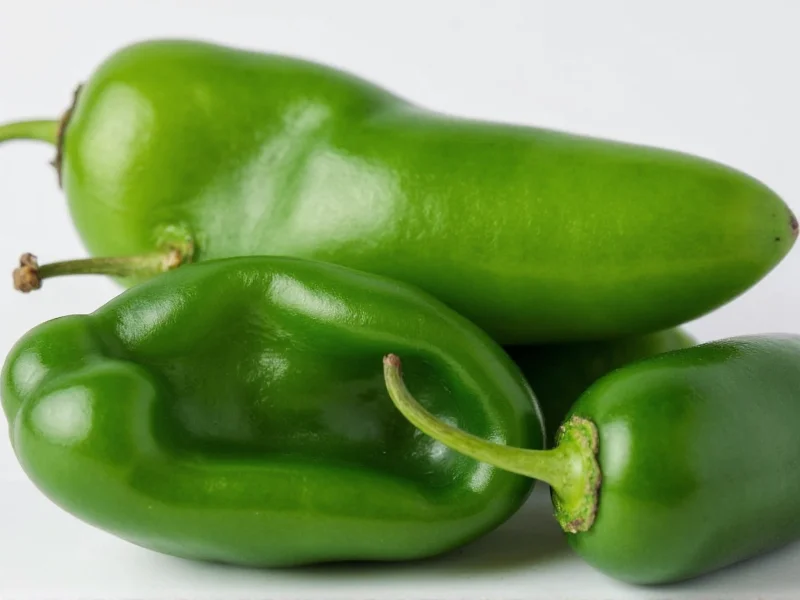Understanding Jalapeño and Serrano Peppers: A Comprehensive Comparison
When selecting peppers for your culinary creations, understanding the differences between jalapeño and serrano varieties is essential for achieving the perfect balance of heat and flavor. Both belong to the Capsicum annuum species but offer distinct characteristics that affect how they perform in various dishes. This detailed comparison examines every aspect that matters to home cooks and professional chefs alike, helping you make informed decisions for your next recipe.
Heat Level Comparison: Quantifying the Burn
The most significant difference between these peppers lies in their heat intensity. Understanding Scoville ratings helps prevent unexpected culinary disasters. While both peppers can vary in heat depending on growing conditions, the general pattern remains consistent.
| Pepper Type | Scoville Heat Units (SHU) | Relative Heat | Comparable Heat Level |
|---|---|---|---|
| Jalapeño | 2,500-8,000 | Moderate | 4-8 times milder than a habanero |
| Serrano | 10,000-23,000 | High | 2-4 times hotter than jalapeño |
When substituting serrano for jalapeno in recipes, use approximately half the amount of serrano to maintain similar heat levels. The heat distribution also differs—jalapeños concentrate most heat in the seeds and ribs, while serranos distribute heat more evenly throughout the flesh.
Flavor Profiles: Beyond Just Heat
Heat isn't the only consideration when choosing between these peppers. Their flavor characteristics significantly impact dish outcomes:
- Jalapeño flavor profile: Earthy, grassy notes with subtle sweetness, especially when mature and red. The thicker walls provide more substantial texture in dishes.
- Serrano flavor profile: Brighter, more citrusy and floral with a cleaner heat. The thinner walls dissolve more readily in cooked dishes.
Chefs often select jalapeños for dishes where pepper texture matters, like stuffed peppers or jalapeño poppers, while serranos shine in blended applications like salsas verde, hot sauces, and marinades where their vibrant flavor can fully integrate.
Physical Characteristics: Visual Identification Guide
Recognizing these peppers at the grocery store prevents recipe mishaps. Here's how to distinguish them:
| Characteristic | Jalapeño | Serrano |
|---|---|---|
| Size | 2-3.5 inches long | 1-2.5 inches long |
| Shape | Thicker, blockier, often slightly curved | Slender, straighter, tapers to point |
| Wall Thickness | Thick (¼ inch) | Thin (⅛ inch) |
| Color Range | Green to red (sometimes purple) | Green to red, orange, or yellow |
| Stem Attachment | Thicker, more robust stem | Thinner, more delicate stem |
Culinary Applications: When to Use Each Pepper
Understanding optimal usage scenarios prevents disappointing results. Consider these guidelines for jalapeno vs serrano in recipes:
Best Uses for Jalapeños
- Stuffed preparations (popper, nachos, cream cheese fillings)
- Charred for chiles rellenos or roasting applications
- Preserved as pickled jalapeños
- Infused in oils or vinegars
- Raw in guacamole or chunky salsas where texture matters
Best Uses for Serranos
- Blended salsas (especially salsa verde)
- Hot sauces requiring clean heat
- Marinades where quick flavor infusion is needed
- Raw in ceviche for bright heat
- Ceviche and fresh pico de gallo
Professional chefs often combine both peppers in complex dishes—using jalapeños for base flavor and serranos for heat accents. This serrano pepper vs jalapeno combination technique creates layered heat profiles that single-pepper recipes can't achieve.
Growing Characteristics for Home Gardeners
If you're considering growing your own peppers, understanding their cultivation needs helps ensure success:
- Jalapeño plants: Grow 2-3 feet tall, produce abundantly, mature in 70-80 days, more tolerant of variable conditions
- Serrano plants: Grow 3-4 feet tall, produce smaller yields, mature in 80-90 days, prefer consistent warmth
Serranos typically develop heat more consistently across growing conditions, while jalapeños can vary dramatically—sometimes producing unexpectedly mild or hot specimens from the same plant. For reliable heat in home gardening, serranos offer more predictable results.
Nutritional Comparison and Health Benefits
Both peppers offer impressive nutritional profiles with some notable differences:
- Both are excellent sources of vitamin C (one pepper provides over 100% daily value)
- Serranos contain slightly higher concentrations of capsaicin, the compound responsible for heat and many health benefits
- Jalapeños have marginally more vitamin B6 and potassium due to their larger size
- Both contain capsiate, a compound showing promise for metabolism support
The jalapeno serrano nutritional differences are minor compared to their heat and flavor distinctions. Both contribute valuable antioxidants and anti-inflammatory compounds to your diet.
Storage and Preservation Techniques
Proper storage maximizes shelf life and flavor retention:
- Refrigeration: Store both peppers in the crisper drawer in a paper bag (not plastic) for 1-2 weeks
- Freezing: Both freeze well when chopped; serranos maintain texture better when frozen whole
- Drying: Serranos dry more evenly due to thinner walls; jalapeños require careful monitoring to prevent burning
- Pickling: Jalapeños are traditional for pickling; serranos create more intensely flavored pickled peppers
For long-term storage, consider roasting and freezing jalapeños for future use in sauces, while serranos work best when processed into hot sauce immediately after harvest.
Common Misconceptions Clarified
Several myths persist about these peppers that can lead to cooking errors:
- Misconception: Red peppers are always hotter than green ones
Reality: Color indicates ripeness, not heat level—both can be hot at any color stage - Misconception: Removing seeds eliminates all heat
Reality: While seeds contain concentrated capsaicin, the compound permeates the entire pepper flesh - Misconception: Larger peppers are always milder
Reality: Size doesn't correlate directly with heat; growing conditions matter more
Making the Right Choice for Your Culinary Needs
Selecting between jalapeño and serrano ultimately depends on your specific recipe requirements and personal heat tolerance. For dishes requiring structural integrity like stuffed peppers, jalapeños are superior. When you need clean, bright heat that integrates seamlessly into liquids, serranos excel. Understanding these differences between jalapeno and serrano peppers transforms your cooking from hit-or-miss to consistently excellent.











 浙公网安备
33010002000092号
浙公网安备
33010002000092号 浙B2-20120091-4
浙B2-20120091-4